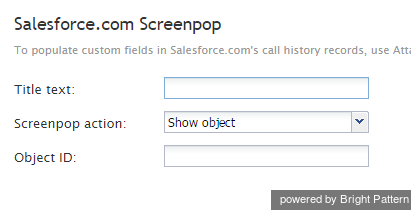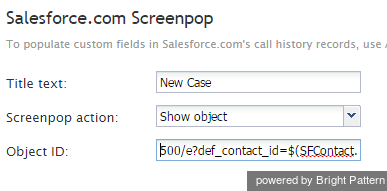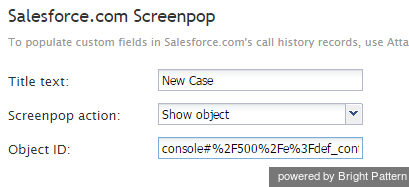SFDCオブジェクト用にスクリーンポップURLの検索または作成
SFDC 統合は、 原則としてSFDCシステム管理者により提供されるスクリーンポップシナリオブロックURLを使うことによって、Saleforce.com (SFDC)の特定のオブジェクトをスクリーンポップ候補とし、アクセスを可能にします。 一方、以下の手順は、SFDCオブジェクトスクリーンポップURLの作成方法を説明する例として挙げられます。
Bright Patternコンタクトセンターは、 Salesforce.com スクリーンポップ シナリオブロックを使って、エージェントデスクトップアプリケーションでSFDCレコード(オブジェクト)を表示します。このブロックは、各オブジェクトIDの選択を許可する他、更にスクリーンポップオブジェクトのSFDC URLを提供します。
ご注意: オブジェクトID URLは、Service CloudとSales Cloudで異なる場合があります。従って、一つのシナリオが企業全体に対応できない場合があります。
Locating SFDC Screen pop URLs for Sales Cloud
Utilizing Salesforce, perform the desired task manually that you wish to perform via the screen pop URL. For example, if you are interested in opening a new case from an account and a specific contact within Sales Cloud, you should proceed as follows:
Step 1: Select a Sales Cloud account and create a new case
- From within Sales Cloud, select > Accounts.
- Scroll down to Contacts.
- Select a sample Contact.
- From the Contact record, scroll down to Cases, and then select New Case. A new case record should open, as shown.
Step 2: Configure the URL that identifies the SFDC Object for screen pop
- Copy the page URL as your starting reference:
https://bpdemo-dev-ed.my.salesforce.com/500/e?retURL=%2F003E000000NoeJj&def_contact_id=003E000000NoeJj&def_account_id=001E000000NK3Pl - The URL identifies the SFDC Object parameters required for your screen pop. The initial SFDC URL segment is not required (https://bpdemo-dev-ed.my.salesforce.com/) and should be removed--the desktop integration will use the configured domain URL. The result is as follows:
500/e?retURL=%2F003E000000NoeJj&def_contact_id=003E000000NoeJj&def_account_id=001E000000NK3Pl - The Object parameters contact_id and account_id would be replaced by the scenario-defined objects/variables. For example:
500/e?retURL=%2F003E000000NoeJj&def_contact_id=$(SFContact.Id)&def_account_id=$(SFContact.Account.Id)
Notes
Common Object ID identifiers (as identified by the three leading field characters) are as follows:
- 001 = Account
- 003 = Contact
- 00T = Task
Typically, the retURL or Return URL is not desired unless the requirement is to return to a specific object. By removing the Return URL, the default action will be to return to the original work object.
- Remove this:
retURL=%2F003E000000NoeJj&
- The Final URL is:
500/e?def_contact_id=$(SFContact.Id)&def_account_id=$(SFContact.Account.Id)
This URL will be placed in the Salesforce.com Screenpop block's Object ID field.
Locating SFDC Screen Pop URLs for Service Cloud (Service Console)
Utilizing Salesforce, perform the desired task manually that you wish to perform via the Screen pop URL. For example, if you are interested in opening a new case from an account and a specific contact within Service Cloud, you should proceed as follows.
Step 1: Select a Service Cloud account and create a new case
- From within Service Cloud, select > Accounts.
- Scroll down to a specific account.
- Select a sample account.
- From the Account record selected, scroll down to Contacts.
- Select a sample contact with which to work.
- From the Contact record, scroll down to Cases, and then select New Case. A new Case record should open.
- To locate the behind-the-scenes URL, select the down arrow on the left side, as shown.
Step 2: Edit the new case
Select New Case and click the edit link. This should result in the Link to Share dialog box.
In Link to Share, three options are available:
- Include all primary tabs and subtitles
- Include only this tab
- Create standard Salesforce URL
Step 3: Configure the URL that identifies the SFDC Object for screen pop
- Select “Include only this tab” to provide the simple URL for the screen pop described.
- Copy the page URL as your starting reference:
https://bpdemo-dev-ed.my.salesforce.com/console#%2F500%2Fe%3Fdef_contact_id%3D003E000000NoeJk%26def_account_id%3D001E000000NK3Pm
The URL identifies the SFDC Object parameters required for your screen pop. The initial SFDC URL segment is not required (https://bpdemo-dev-ed.my.salesforce.com/) and should be removed--the desktop integration will use the configured domain URL. The result is:
console#%2F500%2Fe%3Fdef_contact_id%3D003E000000NoeJk%26def_account_id%3D001E000000NK3Pm
The Object parameters def_contact_id and def_account_id would be replaced by the scenario-defined objects/variables.
The URI data format is as follows (for reference only):
%3D = “=” %26 = “&” %2F = “/” %3F = “?”
Thus the result would be the following:
console#%2F500%2Fe%3Fdef_contact_id%3D$(SFContact.Id)%26def_account_id%3D$(SFContact.Account.Id)
Common Object ID identifiers (as identified by the three leading field characters) are as follows:
- 001 = Account
- 003 = Contact
- 00T = Task
This URL will be placed in the Salesforce.com Screenpop scenario block's Object ID field:






